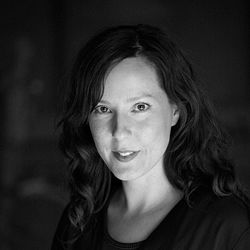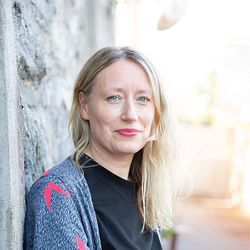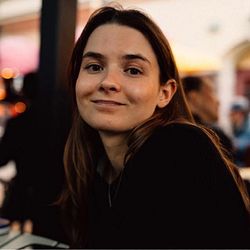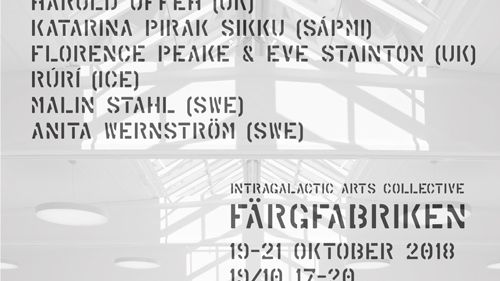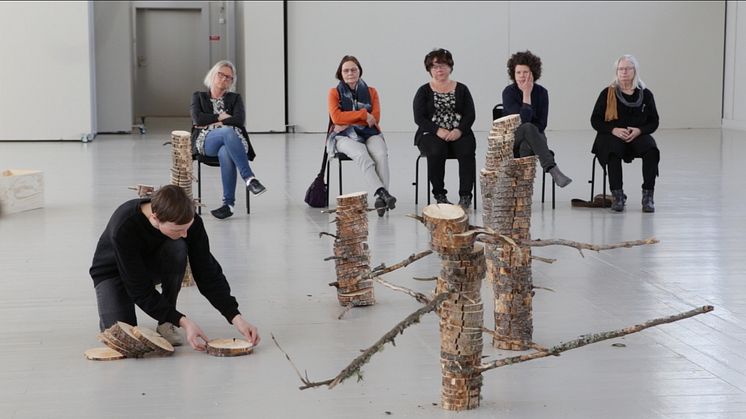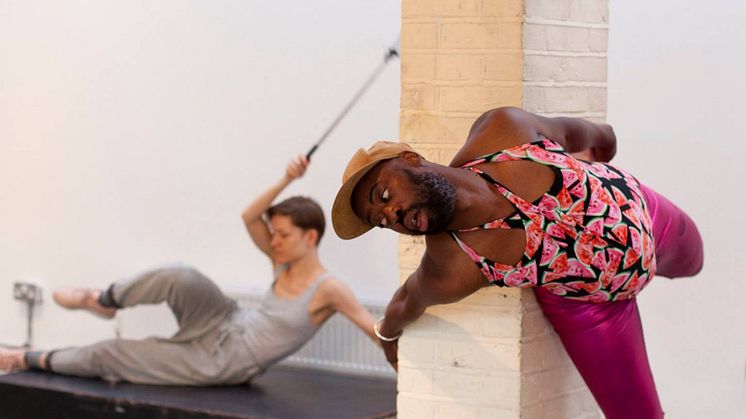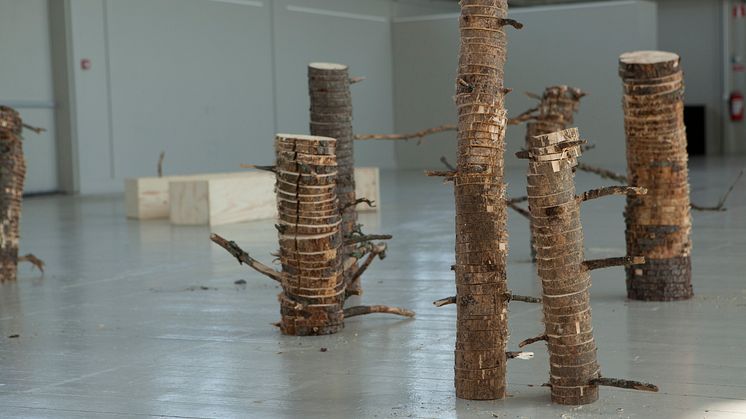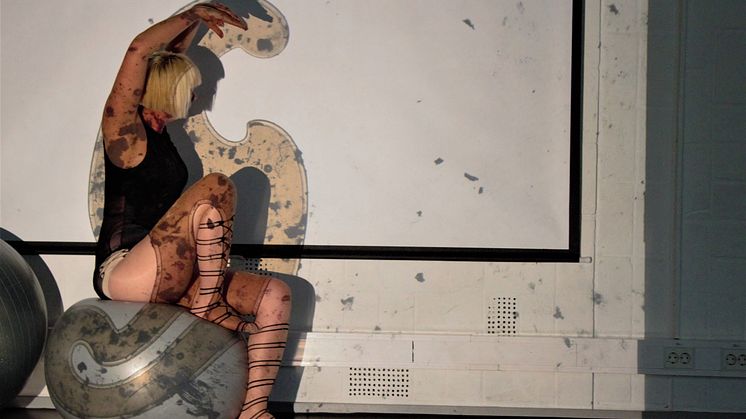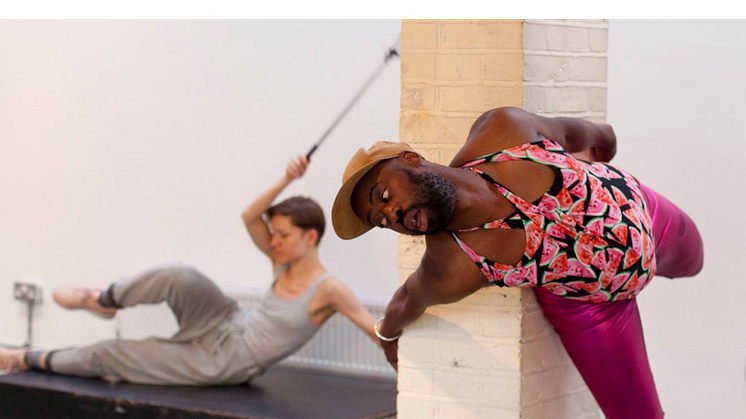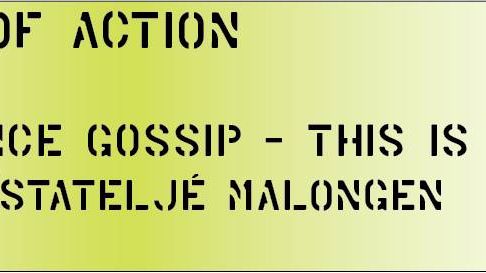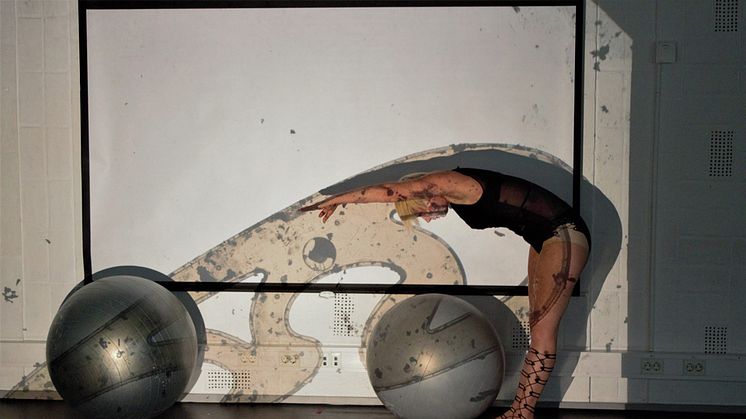
Blogginlägg -
Intervju med Malins Ståhl och Anita Wernström, arrangörer av Faculty of Action (engelska)
Faculty of Action
– acting here and now to develop platforms for performance art
Interview with Malin Ståhl and Anita Wernström, IntraGalactic arts collective.
Malin Ståhl and Anita Wernström are both visual artists with a strong focus on performance art. Through the artist-run initiative IntraGalactic arts collective, they have for several years explored performance art through Performance Lab together with artists, inviting audiences to participate both in the process and the finished works. They are the initiators and organisers of the performance exhibition Faculty of Action taking place at Färgfabriken October 19-21, 2018.
They define performance art as being about presence, creating actions in the here and now. The actions are something that claims time and space for a certain, specific moment. There might be traces such as documentation and props but these should not be confused with the live action.
Faculty of Action offers an ambitions programme with workshops, a seminar and a catalogue on top of an on-going exhibition of live performance pieces. It invites both artists and audience to a furthering of the platforms and theoretical frameworks surrounding performance within the visual arts field.
- Are there important differences between performance art (as visual art) and a theatre play or dance performance?
- One of the defining differences between art forms is their platforms, which is one of the reasons we wanted to develop Faculty of Action. Performance as art exhibition is not yet common in Sweden. It is not an un-known concept internationally and by setting up an exhibition situation with live art pieces (albeit for only three days) we want to connect to that exhibition practice.
As an example we are thinking of the London art scene over the recent decades where performance has been shown both in art institution commissions and in galleries. The Tate has been prominent in building platforms for performance as part of their exhibitions structure with the BMW Tate Live programme and the Tanks, a dedicated performance space that opened in 2012. At Tate Britain the Duveen Commission has included the ‘Work no. 850’ by Martin Creed and Pablo Bronstein’s ‘Historical Dances in an Antique Setting’, both performance pieces. This spring the Chisenhale gallery showed Paul Maheke’s work in A fire circle for a public hearing developing Maheke’s engagement with the potential of the body as an archive.
The theme of the Faculty of Action seminar is ‘what can performance do?’ drawing on our email exchange with Diana Taylor (the Hemispheric Institute). Taylor questions what defines a centre and the western-centered departures in art dialogue, highlighting political, activist performance practices that exist outside of traditional art institutions. Through these practices Taylor sees the ability to make injustice visible and instigate paths towards change. When bringing the question of ‘what can performance do?’ to the Stockholm art scene we see the potential in the commercial dis-interest in the art form. Performance can operate within a certain artistic freedom. There can be space for resistance and activism.
- Any observations about the Stockholm-context?
In Stockholm we are observing a tendency where art institutions and funding bodies are changing their approaches. We notice institutions are opening up towards the performance field with new programming and hosting open calls for artists. The Swedish arts funding bodies and commissioners have recently started to open up towards more transparent processes and reaching out beyond their networks. We see performance as an art form able to bring forth dialogue and the hereto marginalised with an objective to move forward. As Diana Taylor phrases it in ‘Performance’ (2012, Duke University Press) ‘breaking norms is the norm of performance’.
- What is the difference between performing an art piece in a contemporary art context (like a gallery or Kunsthalle) or in other types of spaces not intended for art (like public spaces or other types of culture buildings)?
Perhaps the main difference between performing in different spaces is how this reflects on the artist’s CV. Showing the same performance in the street/a festival or in a space backed by a renowned art institution comes across very differently in a CV. As a result this directly affects the artists’ possibilities to be awarded grants and secure funding. For practitioners trained as visual artists we see it as crucial to be able to practice and exhibit within the area of visual arts also when choosing the medium of performance.
As practicing artists working with performance we are aware of how performance is often used as entertainment to spice up an opening event or part of a programme around the main exhibition. Often the performing artists are not included in the list of exhibiting artists. This curatorial method undermines performance as an artform on equal terms with other expressions such as painting, installation, video and other static interventions. The strategy leaves performance in the realm of spectacle, only there for entertainment and void of activating the political edge of live confrontation that is the inherent potential of the medium.
- How does the space affect how the artwork (performance piece) is presented and percieved?
We identify at least two methods in developing work. One method departs in developing a concept that then looks for a suitable space. Another method begins with the space or place and then develops a concept around that. The practice of beginning with the development of the piece, which can be seen as equivalent to studio practice, is rather marginalised in working with performance. More often the artist is asked, or commissioned, to respond to a place and its social situation.
Artists undergo several years of university training to develop methods of working with tools that, in everyday language, we often refer to as intuition. Even when working with the unknown, and knowledge that is yet ephemeral, the artist has a platform of training and experience to undertake the inquires of their practice.
Performance practices are very dependent on what platforms and spaces are available to them. At times, concerns and interests might bring the artist out of the art institution and into a forest. The conceptual significance of the space can, in such instances, be more important than having access to an audience.
There is no space that does not have a history that one has to take into consideration.
- A performance happens in the present and in relation to the space and the audience - how do you think the fact that other performances will be going on simultaneously in Faculty of Action will affect how the audience perceives the performance works, and how will it affect the performance itself? Traditional group exhibitions are very common, and there are many curatorial methods to make the artworks ”talk to each other”, enhance different aspects of a theme, juxtapose different perspectives etc. But group exhibitions of live performance artworks (as opposed to documentation of previous performances) are not as common, and perhaps the curatorial methods are not as self-evident? How did you approach the possibilities of ”leakage” between the artworks (of sound, light, visual space etc)?
For us, in IntraGalactic arts collective, it is very important that we are not seen as curators operating above the artists, but as ‘artists as organisers’. This means that we have not brought a theme or concept to Faculty of Action. Instead we have invited artists whose practices we find interesting and important. We have encouraged the artists to bring work that they are themselves deeply interested in developing and working on without the curator’s expectation on a certain outcome.
We believe in process and do not feel an absolute need to be in control of what is brought into the exhibitions space. That said, we do not accept anti-democratic or illegal work, and as the artists are finalising their ideas we do what we can to facilitate their wishes. There will indeed be leakage between the pieces, which will be interesting to see how it is possible to work around or relate to. The artists are not invited to do specifically durational pieces so there will be a flux in what is going on at any given moment.
With eight live artworks included in the exhibition we are confident in giving mandate to the audience to choose their perspective. By not controlling space and time through programming and designated seating areas our goal is to create an inclusion of the audience in how they choose to approach and experience the art works on display. It is about the here and now, and to be present in the room.
Image: Keeping Shape, Anita Wernström
